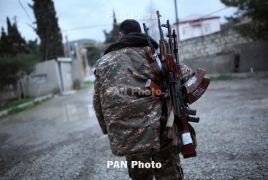 6 simple facts about Armenia–Karabakh–Azerbaijan triangleEverything you need to know The recent escalation on the border between Armenia and Azerbaijan may give rise to a plethora of questions, from the origin of the conflict to the periodic resumption of hostilities and a whole set of developments stemming from pretty much each other. While the Nagorno Karabakh conflict goes back many decades, folks in the West are not much aware of anything. PanARMENIAN.Net - To answer all the questions you might have, PanARMENIAN.Net has compiled a fact sheet-style article to give you a basic insight into the matter. Who is who in the triangle Armenia, Nagorno Karabakh (Artsakh) and Azerbaijan are all countries in the South Caucasus. Armenia is a Christian nation, Azerbaijan is a Turkic Muslim one, while Nagorno Karabakh (historically known as Artsakh among Armenians), is a de facto independent, though yet unrecognized republic in a region that has for ages been populated by Armenians. Armenia has always been supporting Karabakh. The roots of the conflict now go back to 1918-1920, when the newly established Azerbaijan, backed by Turkey, sought to seize Karabakh, but Armenians crushed their plans after all. When the Russian communists took hold of South Caucasus (then Transcaucasia) in the early 1920s, however, Soviet leader Joseph Stalin made a hasty decision to annex Karabakh to the newly-Sovietized Azerbaijan. Armenia and the Armenians in Karabakh were against the decision but could do nothing about it. Armenians refusing to give in The policies pursued by the Azerbaijani authorities brought the number of Armenians in Karabakh to a gradual decline, with local authorities hindering the economic, educational and cultural development of Armenians, closing Armenian schools and hampering the Karabakh residents’ communication with Armenia. At the same time, the number of Azerbaijanis living in Karabakh was artificially increased, more settlements were built for them. The war that set the record straight In 1988, Armenians started a national movement in Karabakh seeking to secede from Azerbaijan and reunite with Armenia. The Azerbaijani authorities, however, responded to the Karabakh people’s determination with massacres and deportations they masterminded and perpetrated in a number of settlements. The Soviet Army then moved to rid Karabakh of Armenians, with Artsakh resolving to fight against the Soviet and Azerbaijani forces. Once the Soviet Union fell, the already independent Azerbaijan went on fighting Karabakh. The Armenians managed to keep Karabakh, but at a price: they lost one region and parts of two others, ultimately managing to take seven regions that were annexed from Armenia and Karabakh and given to Azerbaijan back in the 1920s. The Four Day War (the April War) and its aftermath Azerbaijan did not accept defeat. More than two decades after a fragile peace full of border incidents and losses, Azerbaijan resumed hostilities against Karabakh on April 2, 2016․ Throughout the four-day military campaign, 64 soldiers, 13 volunteers and four civilians, including a child, were killed and more than 120 people were wounded on the Armenian side. According to information from the U.S. Department of State, Azerbaijan lost more than 270 people in total. Armenia’s proposal to meet halfway and Azerbaijan’s refusal to cooperate Following Armenia’s “velvet revolution” of 2018, opposition leader Nikol Pashinyan became the country’s new Prime Minister and introduced a fresh approach to the Karabakh peace process. Not once has the Prime Minister declared that any settlement to the conflict must be acceptable for the peoples of Armenia, Karabakh and Azerbaijan. But Pashinyan’s proposal has never been reciprocated, with the Azerbaijani President Ilham Aliyev claiming on many occasions that any resolution must be acceptable for one of the sides only – Azerbaijan. In recent years, Aliyev has also made claims about Armenia being Azerbaijan's “historical home”, maintaining that Azerbaijanis' return to those territories “is our political and strategic goal, and we need to work step-by-step to get closer to it.” When and how the new round of escalation began Both Armenia and Azerbaijan have been hardly hit by the coronavirus pandemic but the situation in Azerbaijan has been getting worse amid the plunging oil prices, major water shortage problems and widespread corruption in the country. The Aliyev family has been at the helm of the country since Soviet times – throughout 40 years – and has accumulated billions inside the country and abroad. (See, for instance, references from a Panama Papers investigation and Azerbaijani journalist Khadija Ismayilova’s project about the family. Unlike Aliyev, though, ordinary people are not wealthy – average salary in oil-rich Azerbaijan is $355, lower than in neighboring Armenia and Georgia ($372 and $399, respectively). The state of political freedoms is not ideal in either of the countries but Armenia has seen a big progress after the revolution, which was acknowledged by international organizations. In particular, the country recorded the largest-ever democracy score jump in Freedom House’s Freedom in the World report, climbing to the 120th spot and leaving Azerbaijan behind in the 192nd. As there are no civil liberties, opposition and elections in Azerbaijan, social problems can easily turn into a revolution. So Aliyev always uses the Armenia card to divert the public’s attention from domestic problems. The epidemic, the falling oil prices and the world crisis hit the people of Azerbaijan hard, so the country’s authorities returned to their old tradition. Aliyev gave a speech on May 29, declaring, again, that Armenians must abandon Karabakh, claiming, again, that Azerbaijan has “gifted” Yerevan to Armenia, and hinted at the possibility of deploying the army. So who is standing behind the recent escalation? You are welcome to make your own conclusions. Who is who in the web of so many Sargsyans Controversy in quotations Split of opposition votes There will be no ideal solution Main arguments of Armenia’s first President Bizarre election promises From concessions to reunion |